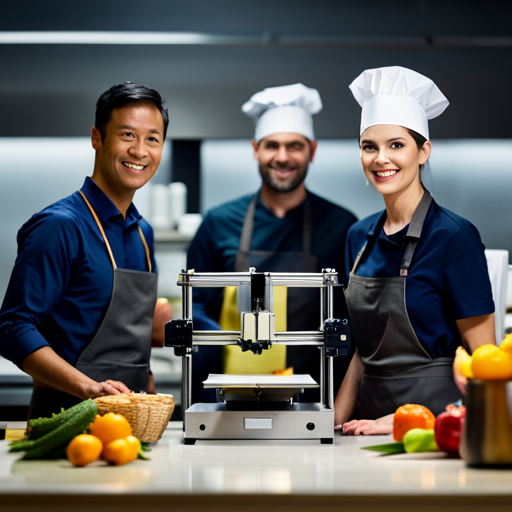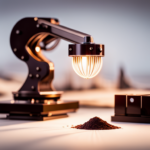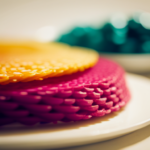In the rapidly evolving landscape of food production, the marriage of 3D printing technology and culinary arts has opened up new frontiers of efficiency and innovation.
‘Maximizing Efficiency in Food 3D Printing Operations’ delves into the cutting-edge strategies and best practices for optimizing the intricate processes involved in 3D printing food.
By juxtaposing traditional culinary techniques with advanced manufacturing principles, this article presents a comprehensive guide for enhancing productivity and quality in the realm of food 3D printing.
Understanding 3D Printing Processes
The understanding of the 3D printing processes is essential for achieving optimal efficiency in food 3D printing operations. Printing parameters, including layer height, printing speed, and nozzle temperature, play a crucial role in determining the quality and accuracy of the printed food products. These parameters need to be carefully calibrated to ensure the desired texture, taste, and appearance of the printed food items.
Moreover, a deep understanding of material properties, such as viscosity, elasticity, and flow behavior, is vital for selecting the most suitable ingredients for the 3D printing process. Different materials may require specific handling and processing techniques to achieve the desired printing results.
Selecting Optimal Ingredients
Understanding the intricacies of 3D printing processes and material properties is crucial for selecting optimal ingredients in food 3D printing operations. When it comes to ingredient selection, there are several key considerations to keep in mind:
-
Flavor Profiles: Ingredients should not only be suitable for 3D printing but also retain their flavor and texture after the printing process.
-
Nutritional Considerations: Optimal ingredients should align with the desired nutritional content, ensuring that the printed food meets specific dietary requirements.
-
Cost-effective Options: Balancing quality with cost is essential. Identifying ingredients that are both high-quality and cost-effective is crucial for the overall efficiency of food 3D printing operations.
-
Texture and Consistency: Ingredients must be able to maintain the required texture and consistency throughout the printing process to ensure the final product’s integrity.
-
Safe and FDA-Approved Ingredients: It is imperative to use ingredients that are safe for consumption and comply with FDA regulations.
Considering these factors, the selection of optimal ingredients plays a pivotal role in the success of food 3D printing operations, impacting the taste, nutritional value, and overall cost-effectiveness of the printed food.
Transitioning into the subsequent section, it is essential to explore the implementation of a production workflow that integrates these carefully selected ingredients seamlessly.
Implementing Production Workflow
In the process of implementing production workflow in food 3D printing operations, it is essential to focus on streamlining process steps, optimizing equipment placement, and minimizing material waste.
These points are crucial for enhancing operational efficiency and productivity. By addressing these key areas, food 3D printing operations can effectively maximize their output while minimizing resources and time.
Streamlining Process Steps
To maximize efficiency in food 3D printing operations, it is essential to implement a streamlined production workflow. This involves process automation and resource allocation optimization.
Streamlining process steps can significantly impact the overall efficiency and productivity of food 3D printing operations. Here are five key strategies to achieve this:
- Integration of automated cleaning processes to minimize downtime and maintenance.
- Utilization of predictive maintenance technology to proactively address equipment issues.
- Implementation of standardized operating procedures to ensure consistency and reduce errors.
- Utilizing advanced scheduling and production planning software to optimize resource utilization.
- Adoption of real-time monitoring and analytics to identify bottlenecks and optimize workflow.
Optimizing Equipment Placement
For maximizing efficiency in food 3D printing operations, it is crucial to carefully consider and plan for the optimal placement of equipment within the production workflow. Efficient equipment layout is essential for streamlining the workflow, reducing material handling, and minimizing production downtime.
By strategically placing 3D printers, post-processing stations, and material storage units, operators can minimize movement between workstations and optimize the flow of materials and products. Workflow optimization also involves integrating automated systems and robotics where feasible to further enhance efficiency.
Additionally, considering factors such as access to utilities, ventilation, and safety requirements is vital in the equipment placement strategy.
Minimizing Material Waste
Implementing an efficient production workflow is essential for minimizing material waste in food 3D printing operations. To achieve this, consider the following strategies:
- Utilizing advanced software for precise material calculations
- Implementing just-in-time material ordering to reduce excess inventory
- Regularly calibrating and maintaining 3D printing equipment to ensure accurate material usage
- Training staff on efficient material handling and reducing human errors
- Implementing a comprehensive recycling program for unused or excess materials
Utilizing Advanced Printing Techniques
By incorporating advanced printing techniques into food 3D printing operations, manufacturers can significantly enhance precision and efficiency in the production process. Material innovation plays a crucial role in advancing 3D printing capabilities. With the development of edible materials specifically designed for 3D printing, manufacturers can achieve higher printing precision and consistency, allowing for more intricate and complex designs to be realized. Additionally, these innovative materials can contribute to improved taste, texture, and nutritional value of the printed food products, meeting consumer demands for high-quality, personalized food items.
Furthermore, quality control and post-processing techniques are essential components of advanced 3D printing operations. Implementing advanced quality control measures such as real-time monitoring and automated inspection systems can ensure that the printed food items meet safety and quality standards. Moreover, post-processing techniques, such as precision cutting and surface finishing, can further enhance the visual appeal and overall quality of the printed food products.
Managing Equipment and Maintenance
In order to ensure smooth and efficient food 3D printing operations, it is crucial to focus on managing equipment and maintenance.
This involves implementing rigorous equipment cleaning protocols, adhering to preventive maintenance best practices, and effectively managing repair schedules.
These aspects are essential for sustaining the longevity and optimal functionality of the 3D printing equipment, ultimately contributing to enhanced operational efficiency.
Equipment Cleaning Protocols
Maintaining equipment cleanliness is essential for efficient food 3D printing operations. It ensures the production of safe and high-quality printed foods.
Key considerations for equipment cleaning protocols include:
-
Cleaning Validation: Implementing processes to verify the effectiveness of cleaning methods.
-
Sanitation: Utilizing appropriate cleaning agents and techniques to eliminate contaminants.
-
Equipment Hygiene: Establishing regular cleaning schedules and procedures for all components.
-
Sterilization: Utilizing methods to eradicate microorganisms and ensure the sterility of equipment.
-
Maintenance: Regularly inspecting and servicing equipment to prevent malfunctions and contamination.
Preventive Maintenance Best Practices
Effective management of equipment and maintenance is crucial for optimizing food 3D printing operations. Maintenance scheduling plays a key role in preventing unexpected breakdowns and ensuring the smooth functioning of 3D printing equipment.
Implementing a proactive maintenance schedule based on equipment usage and manufacturer recommendations can significantly improve equipment reliability. Regular inspections, lubrication, and part replacements at scheduled intervals help in identifying and addressing potential issues before they escalate, thus minimizing downtime.
Additionally, monitoring equipment performance and implementing predictive maintenance techniques, such as vibration analysis and thermography, can further enhance reliability.
Managing Repair Schedules
Implementing a systematic approach to managing repair schedules is essential for ensuring the continued reliability and optimal performance of food 3D printing equipment.
- Regularly schedule preventive maintenance to identify and address potential issues before they escalate.
- Keep detailed records of equipment performance and maintenance history to inform repair scheduling.
- Prioritize urgent repairs to minimize downtime and maintain production efficiency.
- Coordinate with equipment suppliers or technicians to ensure timely availability of spare parts for repairs.
- Utilize predictive maintenance technologies to anticipate potential failures and schedule proactive repairs.
Scheduling repairs and managing maintenance is crucial for the seamless operation of food 3D printing equipment. By effectively managing repair schedules, businesses can minimize disruptions and maintain consistent production output.
This proactive approach ultimately contributes to ensuring food safety and compliance.
Ensuring Food Safety and Compliance
To ensure food safety and compliance in food 3D printing operations, it is crucial to adhere to stringent regulatory standards and best practices throughout the entire production process.
Regulatory compliance is paramount in the food industry, and this holds true for 3D printed food as well. Establishing and maintaining compliance with food safety measures set by regulatory bodies ensures that the end products are safe for consumption. This involves careful monitoring of raw materials, production processes, and the final printed food items. Adhering to these standards not only ensures the safety of the food products but also builds trust with consumers and regulatory agencies.
In addition to adhering to regulatory standards, it is essential to implement robust internal quality control measures to further enhance food safety and compliance. This includes regular equipment maintenance, sanitation protocols, and quality assurance checks throughout the 3D printing process. By integrating these measures into the operational framework, food 3D printing businesses can uphold the highest standards of safety and compliance.
Transitioning into evaluating performance and iteration, it is important to continually assess and refine these processes to maintain the highest level of safety and compliance in food 3D printing operations.
Evaluating Performance and Iteration
The company’s thorough evaluation of performance and iteration is integral to maintaining efficiency in food 3D printing operations.
- Continuous improvement: Regularly assessing and refining processes to optimize efficiency.
- Data-driven analysis: Utilizing performance metrics and data to identify areas for improvement.
- Iterative prototyping: Testing and refining 3D printed food products to enhance quality and consistency.
- Process improvement initiatives: Implementing strategies to streamline printing processes and reduce waste.
- Feedback integration: Incorporating feedback from customers, employees, and stakeholders to drive iterative enhancements.
Evaluating performance and iteration is crucial for ensuring that food 3D printing operations remain efficient and effective. By continuously assessing and improving processes, the company can enhance productivity, minimize errors, and deliver high-quality 3D printed food products.
Through data-driven analysis and iterative prototyping, the company can identify opportunities for process improvement and refine its printing techniques.
Moreover, integrating feedback from various sources allows for a comprehensive approach to enhancing performance and iteration in food 3D printing operations.
Frequently Asked Questions
How Can 3D Printing Technology Be Integrated With Traditional Cooking Techniques in a Food 3D Printing Operation?
Integrating 3D printing technology with traditional cooking techniques in a food operation involves designing textures and integrating flavors. This fusion allows for precise customization and innovative culinary experiences, enhancing the overall dining experience.
What Are the Best Practices for Minimizing Waste and Maximizing Efficiency in a Food 3D Printing Operation?
To minimize material waste and maximize speed in food 3D printing operations, best practices include streamlining design processes, optimizing printing parameters, and monitoring material usage. These measures ensure efficient resource allocation and swift production turnaround.
How Can Food 3D Printing Operations Adapt to Changes in Consumer Preferences and Dietary Restrictions?
Adapting recipes and ingredient sourcing are vital for food 3D printing operations to cater to evolving consumer preferences and dietary restrictions. Understanding and incorporating these changes ensures the production of relevant and desirable food products.
What Are Some Innovative Ways to Collaborate With Food 3D Printing Technology Companies to Improve Efficiency?
Collaborative partnerships with food 3D printing technology companies can drive efficiency through shared research, co-developed systems, and optimized supply chains. Technology integration fosters innovative solutions, enhancing production, quality, and sustainability in food 3D printing operations.
What Are the Key Considerations for Scaling up a Food 3D Printing Operation to Meet Increased Demand?
Scaling up a food 3D printing operation to meet increased demand involves addressing various challenges, such as production optimization, supply chain management, and technology scalability. Key considerations include efficient resource allocation and process streamlining.
Conclusion
In conclusion, maximizing efficiency in food 3D printing operations requires a comprehensive understanding of printing processes, optimal ingredient selection, and efficient production workflow implementation.
Utilizing advanced printing techniques, managing equipment and maintenance, and ensuring food safety and compliance are also crucial factors.
Evaluating performance and iteration are essential for continuous improvement.
Just as the saying goes, ‘a well-oiled machine,’ a well-managed and efficient food 3D printing operation can produce high-quality and innovative food products.


